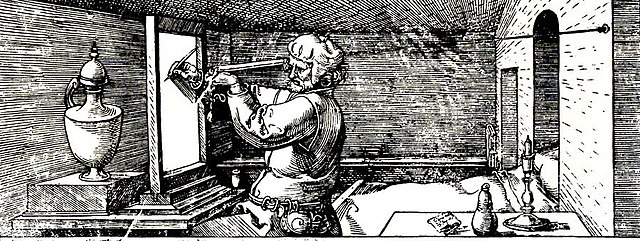In 3D computer graphics, ray tracing is a technique for modeling light transport for use in a wide variety of rendering algorithms for generating digital images.
Dürer woodcut of Jacob de Keyser's invention. With de Keyser's device, the artist's viewpoint was fixed by an eye hook inserted in the wall. This was joined by a silk string to a gun-sight style instrument, with a pointed vertical element at the front and a peephole at the back. The artist aimed at the object and traced its outline on the glass, keeping the eyepiece aligned with the string to maintain the correct angle of vision.
The number of reflections, or bounces, a "ray" can make, and how it is affected each time it encounters a surface, is controlled by settings in the software. In this image, each ray was allowed to reflect up to 16 times. Multiple "reflections of reflections" can thus be seen in these spheres. (Image created with Cobalt.)
3D computer graphics, sometimes called CGI, 3-D-CGI or three-dimensional computer graphics, are graphics that use a three-dimensional representation of geometric data that is stored in the computer for the purposes of performing calculations and rendering digital images, usually 2D images but sometimes 3D images. The resulting images may be stored for viewing later or displayed in real time.
A 3-D rendering with ray tracing and ambient occlusion using Blender and YafaRay
A 3-D model of a Dunkerque-class battleship rendered with flat shading
During the 3-D rendering step, the number of reflections "light rays" can take, as well as various other attributes, can be tailored to achieve a desired visual effect. Rendered with Cobalt.
A 3-D rendering of a penthouse






